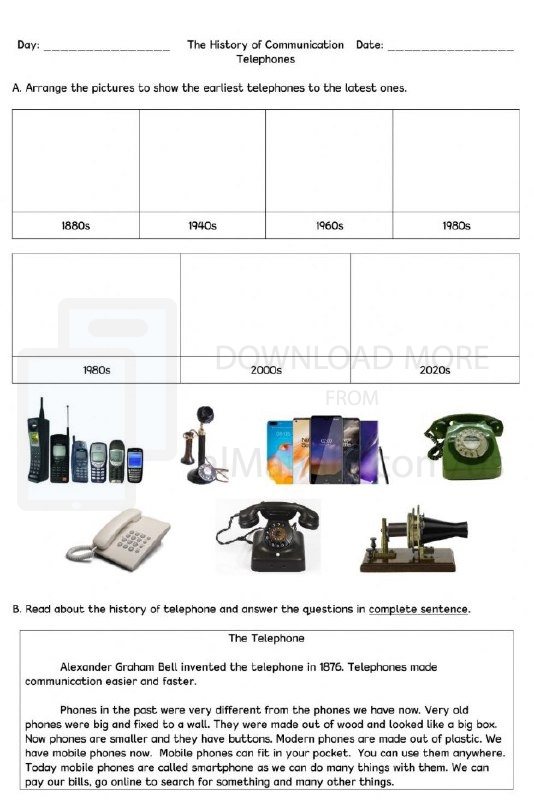| You are here: Almanahj Website ⇒ American curriculum ⇒ 5th Grade ⇒ Information and comm ⇒ Term 1 | ||
|---|---|---|
Worksheet about History of Communication and Telephones | ||
|---|---|---|
| Subject: Information and comm | ||
| 5th Grade | ||
| Term 1 | ||
| Year: 2023/2024 | ||
| Size: 279.6KB | ||
| Number of clicks: 92 | ||
| Publish date:November 17, 2023 | ||
| Added by: Eman | ||
| Last download date: 2024-09-11 09:37:53 | ||
| Updated by: Eman9966 on 2023-11-17 16:37:48 | By: theodor osccarthecow1 | |
| File info: History of Communication Communication is the fundamental aspect of human interaction, enabling us to share thoughts, ideas, and emotions with one another. It has evolved over millennia, from basic gestures and vocalizations to sophisticated forms of written and electronic communication. Early Forms of Communication: Gestural and Vocal Communication: Humans have communicated through gestures and vocalizations since their earliest existence. These forms of communication allowed for the exchange of basic information and emotions. Pictographs and Hieroglyphs: The development of writing systems marked a significant advancement in communication. Pictographs, which used symbols to represent objects or ideas, and hieroglyphs, which combined pictographs and phonetic elements, enabled more complex information to be recorded and transmitted. Spoken Languages: With the increasing complexity of human societies, spoken languages emerged, allowing for more nuanced and abstract communication. Languages evolved over time, reflecting cultural differences and historical developments. Technological Advancements in Communication: Printing Press: The invention of the printing press in the 15th century revolutionized communication, enabling the mass production of books and written materials. This led to a wider dissemination of knowledge and ideas, fostering intellectual and cultural growth. Telegraph: In the 19th century, the telegraph emerged as a means of transmitting electrical signals over long distances. This technology enabled rapid communication between distant locations, transforming business and government operations. Telephone: The invention of the telephone in 1876 by Alexander Graham Bell ushered in a new era of communication. Telephones allowed for real-time voice communication over long distances, revolutionizing personal and professional interactions. Radio and Television: The development of radio and television in the 20th century further expanded the reach and impact of communication. These technologies enabled mass broadcasting of news, entertainment, and educational content, shaping public opinion and cultural trends. The Rise of Digital Communication: Internet: The advent of the internet in the late 20th century transformed communication once again. The internet provides a global platform for information sharing, enabling instant messaging, email, social media, and online collaboration. Mobile Communication: The widespread adoption of mobile phones has made communication even more accessible and ubiquitous. Mobile devices allow for voice calls, text messages, and internet access, enabling seamless communication from anywhere in the world. Communication in the Modern Age: Communication has become an integral part of modern life, shaping how we interact, learn, and work. The constant evolution of communication technologies continues to redefine the way we connect, collaborate, and share information with one another. The Future of Communication: As technology advances, the future of communication holds exciting possibilities. Artificial intelligence, virtual reality, and other emerging technologies are poised to further transform the way we communicate, enabling even more immersive, personalized, and interconnected forms of interaction. Conclusion: Communication has played a pivotal role in human history, shaping our societies, cultures, and understanding of the world. From early forms of gestural and vocal communication to the sophisticated digital technologies of today, communication has evolved to meet the needs of a changing world. As we continue to innovate and explore new communication technologies, we can anticipate even more groundbreaking advancements that will redefine the way we connect and share our experiences. | ||
| Downloading link Worksheet about History of Communication and Telephones |
|---|
|
1700221624.pdf
The file is being prepared for download
|
| File images |
|---|
 |